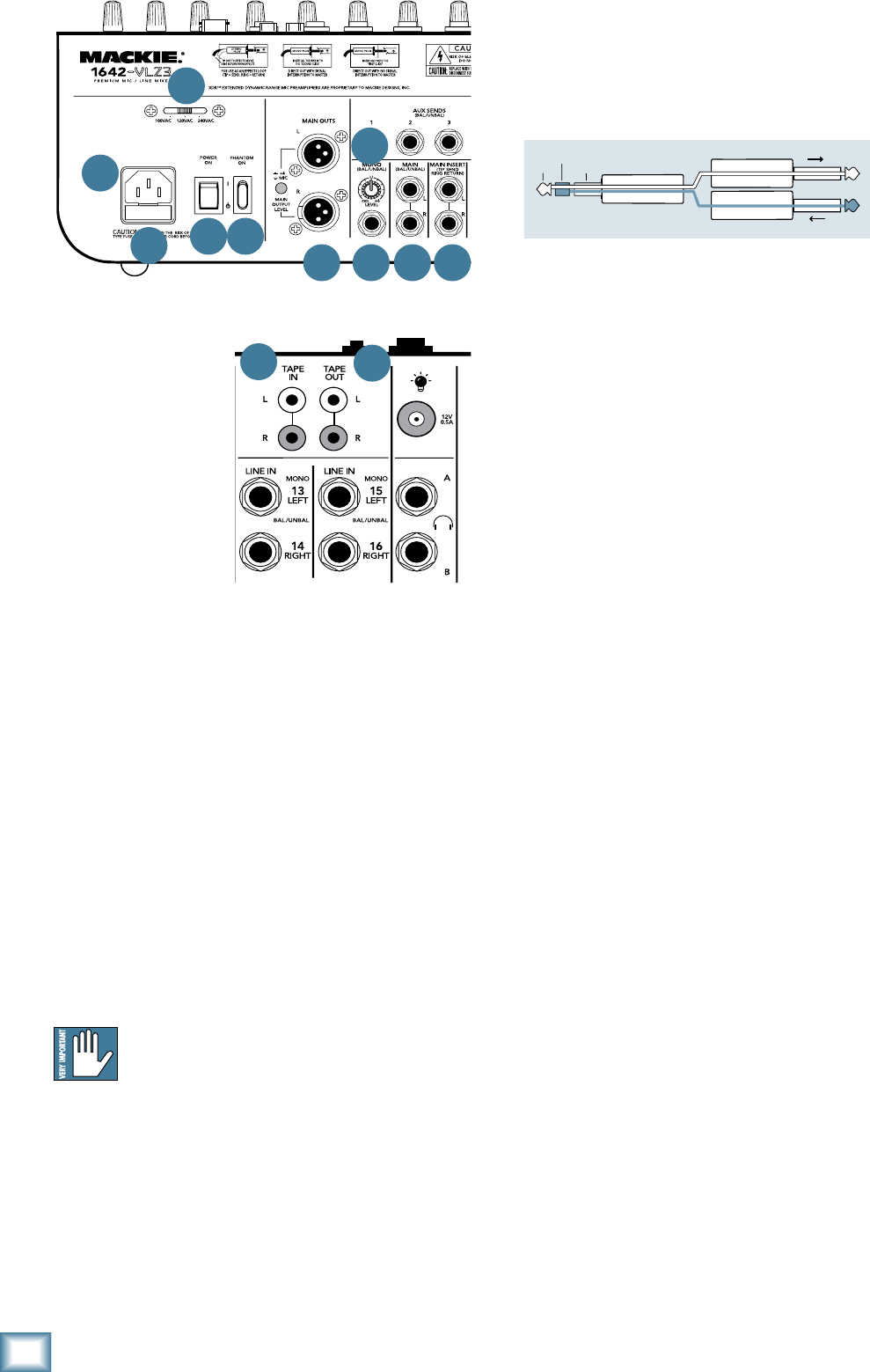
1
164-VLZ3
1642-VLZ3
11. TAPE OUTPUT
These unbalanced
RCA jacks tap the main
mix outputs to make
simultaneous record-
ing and PA work more
convenient. Connect
these to your 2-track
recorder’s inputs.
See MAIN MIX
FADER [37] on page
18 for details of the
signal routing to these outputs.
Mono: If you want to feed a mono signal to your tape
deck or other device, use the 1/4" MONO [15] output
jack instead.
12. TAPE INPUT
These unbalanced RCA jacks are designed to work
with semipro as well as pro recorders. Connect your
2-track tape recorder’s outputs here, using quality hi-fi
RCA cables. To learn how signals are routed from these
inputs see page 19, TAPE IN LEVEL [40].
Use these jacks for convenient playback of your mixes.
You’ll be able to review a mix, and then rewind and try
another pass without repatching or disturbing the mixer
levels. You can also use these jacks with a portable tape
or CD player to feed music to a PA system between sets.
NOTE: Pushing TAPE TO MAIN MIX [41]
in the output section automatically discon-
nects the TAPE [11] OUTPUT from the main
outputs. This prevents creating a feedback loop, which
could create quite a howl in your system (and your audi-
ence!)
13. MAIN INSERT
These 1/4" jacks are for connecting serial effects such
as compressors, equalizers, de-essers, or filters. The IN-
SERT point is after the mix amps, but before the MAIN
MIX fader. Insert cables must be wired thusly:
Tip = send (to effects device inputs)
Ring = return (from effects device outputs)
Sleeve = common ground (connect shield to all
three sleeves)
14. MAIN OUTS
Two sets of jacks are provided for the main out-
puts: 1/4" TRS jacks and XLR jacks. These are usually
patched to the inputs of your 2-track mixdown deck
(unless you’ve chosen to use the TAPE OUTPUT [11]
RCA jacks), or to the house amplifier during live sound
sessions.
In addition, the XLR MAIN OUTS have a switch to
match the signal level to the input of the device you're
connecting them to. Push the switch in to reduce
the output by 40 dB, so you can feed the mic input of
another mixer, for example. Leave the switch out to
connect to professional +4 dBu devices. To learn how
signals are routed to these outputs, see page 18, MAIN
MIX FADER [37].
To use the 1/4" outputs to drive balanced inputs, con-
nect 1/4" TRS (Tip-Ring-Sleeve) phone plugs like this:
Tip = + (hot)
Ring = – (cold)
Sleeve = ground
To use these outputs to drive unbalanced inputs, con
-
nect 1/4" TS (Tip-Sleeve) phone plugs like this:
Tip = signal
Sleeve = ground
15. MONO OUTPUT
It happens to everybody sooner or later: The forces
that govern your world will demand a monaural output
from your painstakingly-created stereo panorama. The
last thing you want to do is start twirling all your care-
fully-placed PAN [31] settings to one side. What to do?
Stick a cord in this 1/4" jack, hand the other end to Mr.
Mono, and you’re done. He’s got his mono mix and you’ve
still got your stereo mix. The MONO output is nothing
more than a sum of the left and right main mix.
19
17
13
11
12
14
16
15
18
20 22
“tip”
This plug connects to one of the
mixer’s Channel Insert jacks.
“ring”
tip
ring
sleeve
SEND to processor
RETURN from processor
(TRS plug)
14


















